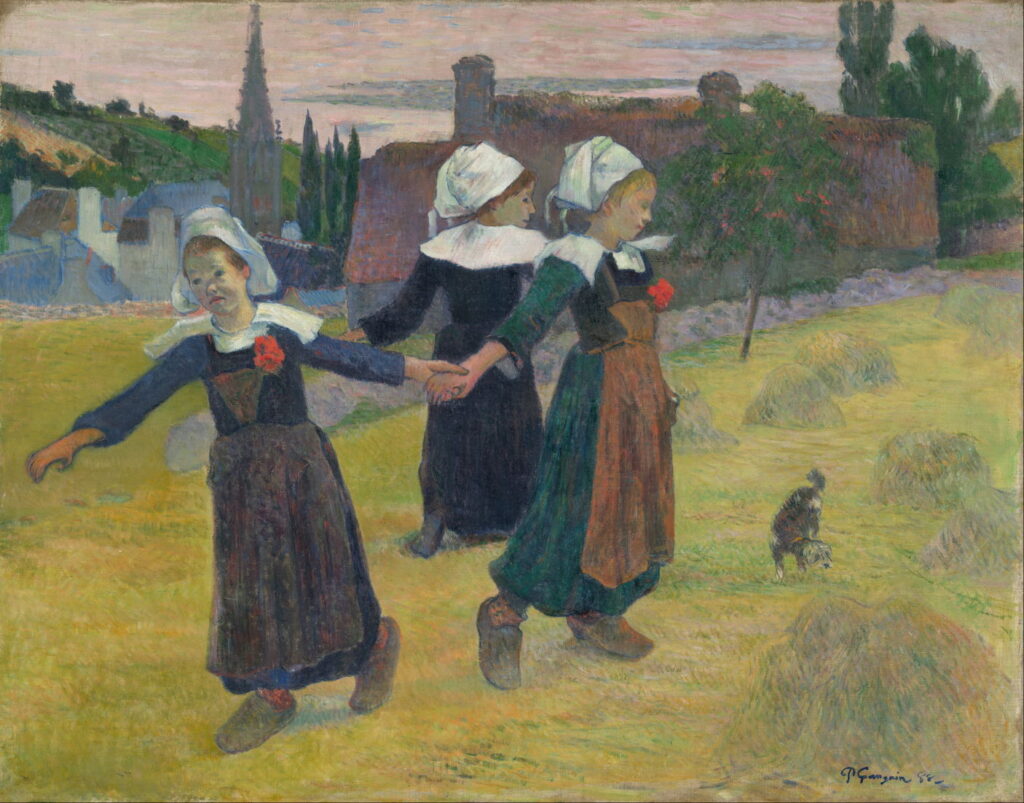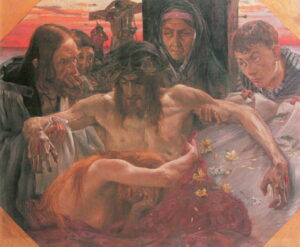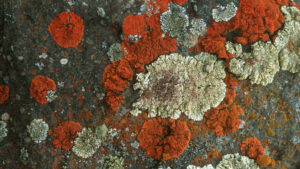Paintings from Pont-Aven: 1860 to Gauguin

Artists, for all their individuality, are a sociable bunch, and group together, although it wasn’t until the popularisation of outdoor landscape painting in the nineteenth century that they formed ‘colonies’. Tiny villages like Barbizon, on the edge of the Fontainebleau Forest in France, had barely attracted attention until 1829, when Corot started to visit each summer. By the middle of the century, it was commonplace to see artists at work around the village and its countryside, and they were quickly known as the Barbizon School, turning a loose geographic association into an art movement of considerable importance.
As the Barbizon School was (all too literally) dying in the late 1860s, another colony was forming, in the village of Pont-Aven in Brittany. This became one of the most popular and influential colonies, visited by hundreds, even thousands of artists, well into the twentieth century. Its most famous member was Paul Gauguin, who was at its centre in the late 1880s, when it was second in importance only to Paris itself as the hub of development in painting.
This weekend’s two articles outline and illustrate its history as an art colony, starting today in the 1860s and passing as far as Gauguin and Émile Bernard in around 1890. Tomorrow takes the story up from there, until 1900.
In 1860, Pont-Aven was a small village straddling the River Aven, some miles inland from the coast of Brittany. A few artists made their way to the village to escape the crowding and cost of living in Paris during the previous decade, but it wasn’t until the railway connected Paris with Quimper in 1862 that reaching Pont-Aven became straightforward.
Otto Weber (1832–1888), Return to the Church (1864), further details not known. Wikimedia Commons.
The German landscape painter Otto Weber arrived in the village in 1863, and the following year painted Return to the Church (1864) somewhere nearby. He exhibited the first of his paintings from Pont-Aven at the Salon in Paris in 1864, left France with the start of the Franco-Prussian War in 1870, and was invited by Queen Victoria to work in Britain from 1872, where he died in 1888.
The year that Pont-Aven first featured in the Salon saw an influx of American painters to the village. Among them was Robert Wylie, who remained painting there until his death in 1877.
Robert Wylie (1839-1877), The Postman (1869), oil, dimensions not known, Pennsylvania Academy of Fine Art, Philadelphia, PA. Wikimedia Commons.
Wylie seems to have been more attracted by the local characters, domestic genre scenes, and probably the low cost of models, than by the local landscape. The Postman (1869) is fairly representative of his surviving work from this time.
More American artists arrived in 1866: Frederick Bridgman (1847–1928), Benjamin Champney (1817–1907), Earl Shinn (1838–1886), and Howard Roberts (1843–1900). Then a couple of years later, the Dutch painter Herman van den Anker (1832–1883) came to the colony too. In view of its later history, that year (1868) brought one of the most surprising painters of all: William Bouguereau.
William-Adolphe Bouguereau (1825-1905), Washerwomen of Fouesnant (1869), oil, dimensions and location not known. Wikimedia Commons.
Bouguereau originated from La Rochelle, further to the south along the coast of the Bay of Biscay, and had already enjoyed a meteoric rise to fame. He had won the Prix de Rome in 1850, studied and painted in Rome from 1851-54, had been awarded the Legion d’Honneur in 1859, and had sold a painting to Napoleon III, which had been hung in the Empress Eugénie’s apartments in the Tuileries. He most probably came to Pont-Aven on completion of four years decorative work at the Grand Théâtre in Bordeaux, to refresh his art with paintings such as the Washerwomen of Fouesnant (1869).
Clement Nye Swift (1846-1918), Harvesters of Seaweed (date not known), further details not known. Wikimedia Commons.
Pont-Aven remained popular, particularly with American artists. This was in part due to the recommendations of teachers such as Jean-Léon Gérôme that their pupils should paint there. In 1870, Clement Nye Swift fled to the village from Paris, at the outbreak of the Franco-Prussian War. He stayed for ten years, during which he painted Harvesters of Seaweed and the majority of his life’s work, exhibiting at the Paris Salon until 1880.
An even more important American artist who came to Pont-Aven at this time was J Alden Weir (1852–1919), who stayed more briefly in 1874 when he was a student at the École des Beaux-Arts in Paris. By this time, the colony was thriving, and truly international in composition. The British painter Adrian Stokes (1854-1935) paid his first visit in 1876, and was to return to Pont-Aven in 1883.
Peder Severin Krøyer (1851–1909), French Forestry Workers on a Track (1879), oil on canvas, 80 × 100 cm, Ribe Kunstmuseum, Ribe, Denmark. Wikimedia Commons.
Peder Severin Krøyer spent the period 1877-81 travelling in Europe, enabling him to study under Léon Bonnat, and to visit Pont-Aven, probably in around 1879, when he painted French Forestry Workers on a Track. He went on to become a key member of the Skagen painters, or Danish Impressionists.
Marianne Stokes (1855–1927), Homeless (On the Way to the Fields) (1885), oil on board, 55 × 38 cm, Private collection. Wikimedia Commons.
The Austrian Marianne Preindlsberger, better known as Marianne Stokes, was at Pont-Aven with her Finnish friend, the painter Helene Schjerfbeck, in 1883 when Adrian Stokes visited, resulting in his later marriage.
In 1886, Paul Gauguin first visited Pont-Aven. He had been a stockbroker by trade and an amateur artist until the Paris markets crashed in 1882, driving him to try to earn his living from his art. He had spent time with his wife and five children in Copenhagen, returning to Paris in 1885. To make ends meet during the winter of 1885-86, he had worked in various menial jobs, and was struggling to paint much. He exhibited at the eighth and final Impressionist Exhibition in Paris in May 1886, then spent the summer in Pont-Aven, where he could live more cheaply than in the capital.
He got on well there, both with the other artists and in his art. He made some pastel drawings of figures, and landscape paintings. Among Gauguin’s new friends there was Charles Laval, who accompanied him in a visit to Panama and Martinique the following year. Later in the summer of 1886, Émile Bernard arrived for his first visit to Pont-Aven, and met Gauguin.
In all, Gauguin visited the colony in 1886, 1888, 1889-90, and finally in 1894. Bernard visited in 1886, 1888, and 1891-93.
Paul Gauguin (1848–1903), Lollichon Field and Pont-Aven Church (1886), oil on canvas, 71.3 × 92 cm, Private collection. Wikimedia Commons.
Lollichon Field and Pont-Aven Church was one of the landscapes painted by Gauguin during his first summer at Pont-Aven, in 1886.
Paul Gauguin (1848–1903), L’Aven en contre bas de la Montagne Sainte-Marguerite (Landscape near Pont-Aven) (1888), oil on canvas, 72.9 x 92.2 cm, Bridgestone Museum of Art ブリヂストン美術館, Ishibashi Foundation, Tokyo, Japan. Wikimedia Commons.
L’Aven en contre bas de la Montagne Sainte-Marguerite (Landscape near Pont-Aven) (1888) shows the River Aven at the foot of Saint Margaret’s Hill, just outside the village.
Paul Gauguin (1848–1903), Breton Girls Dancing, Pont-Aven (1888), oil on canvas, 73 × 92.7 cm, National Gallery of Art, Washington, DC. Wikimedia Commons.
Breton Girls Dancing, Pont-Aven (1888) is one of Gauguin’s most famous paintings from Pont-Aven, and includes a wonderfully scruffy little dog.
Émile Bernard’s initial training had been in decorative arts, but in 1884 he started at the Atelier Cormon, where he made friends with Henri de Toulouse-Lautrec and started to experiment in style. He then progressed to the École des Beaux-Arts, but was suspended from there, so he set off to tour Brittany on foot. In August 1886, the eighteen year-old Bernard arrived in Pont-Aven, where he met Paul Gauguin.
The following year, Bernard was back in Paris at the Académie Julian, where he met Vincent van Gogh. In the summer of 1888, Bernard walked back to Brittany, to meet Gauguin again in Pont-Aven. They became close friends, and discussed their art; Bernard was already pursuing theories about his art and his aims, and apparently impressed Gauguin. At this time, Bernard collaborated with both Gauguin and van Gogh.
Émile Bernard (1868–1941), Farm at Pont-Aven (1887), oil on canvas, 33 × 41.3 cm, location not known. Wikimedia Commons.
Farm at Pont-Aven (1887) shows Bernard’s highly structured brushstrokes, which are often compared with Cézanne’s ‘constructive stroke’. If this is dated accurately, this work was painted after Bernard had left Pont-Aven.
Émile Bernard (1868–1941), Landscape at Pont-Aven (1889), media and dimensions not known, Van Gogh Museum, Amsterdam, The Netherlands. Wikimedia Commons.
In Bernard’s Landscape at Pont-Aven (1889) the similarity of his brushstrokes with those of Cézanne’s late oil paintings is clear.
Émile Bernard (1868–1941), Pont-Aven Seen from the Bois d’Amour (1892), oil on canvas, 72.1 x 92.1 cm, Indianapolis Museum of Art, Indianapolis, IN. Wikimedia Commons.
Bernard painted Pont-Aven Seen from the Bois d’Amour (1892) from the edge of the wood that featured in other landscapes of the village at that time.



